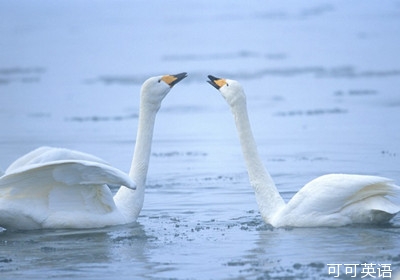In recent years, we've seen a big increase in the numbers of swans across the country. So some people feel that swans are becoming a danger to other river life. To answer this question, here is Paul from the Salmon and Trout Association.
近年來,我們看到整個國家天鵝的數量大幅增加。因此有些人感覺天鵝正在威脅其它的河流生命。為了解答這個問題,現在連線三文魚和鱒魚協會的發言人保羅。

What happens is the swans come along and in deep water, they just graze on it, that's no problem. It's quite resilient and it'll come back. The problem is in low water, they'll eat it right down to the roots and they'll kill it off. The problem here is more (that there is) not enough water in the river.
發生的情況是,天鵝來到深水區,以植物為食,這沒問題。植被的生長具有反彈性,會復原。問題在于淺水區,天鵝會吃掉植物的根部,因而毀掉植被。更嚴重的問題是河流不再有足夠的水。
Although it's difficult to believe that today with all this flood water coming down. That's the real issue. We need more water in the river to provide the depth for fish and birds to coexist side by side. Let's hear from Graham who works for the Royal Society for the Protection of Birds, RSPB.
盡管在洪水泛濫的今天,人們很難相信這個事實。但這是真正存在的問題。我們的河流需要更多的水來為魚和鳥類的共存提供一定的水位空間。讓我們來聽聽在英國皇家鳥類保護協會(RSPB)工作的格雷漢姆的意見。
The amount of water being taken out of the system is unsustainable, and also the amount of pollutants from washing achines and from farmland run-off coming into these rivers are also causing problems. So yes, let's look at the problems swans are causing, but let's look at the much bigger environmental picture too. That is historically the case, but these days all swans are protected under the wildlife and countryside act.
從水生系統流失的水是不可再生的,流向河流的大量洗滌和農田徑流污染物也導致了這一問題。是的,讓我們來看看天鵝造成的威脅,同時我們來看看宏觀的環境現狀。這是歷史遺留下來的問題,所有的天鵝都屬于皇室,它們都受到法律保護。












